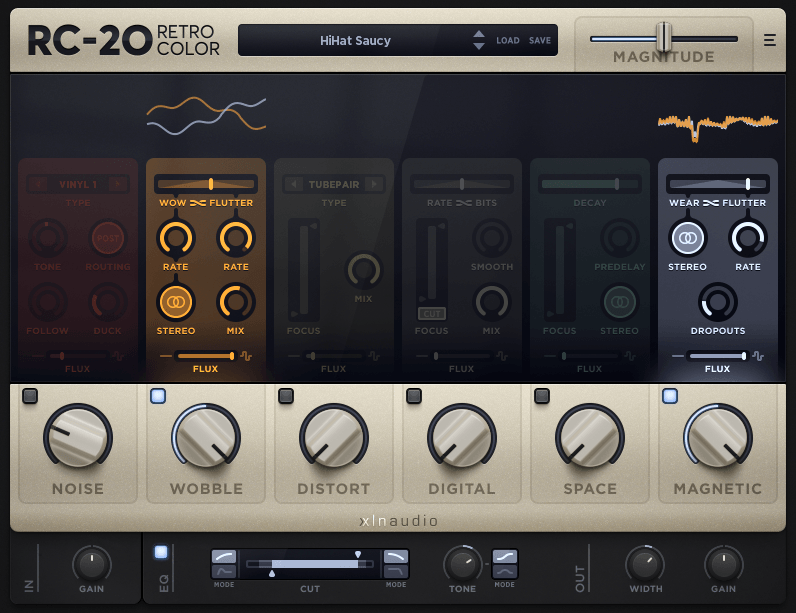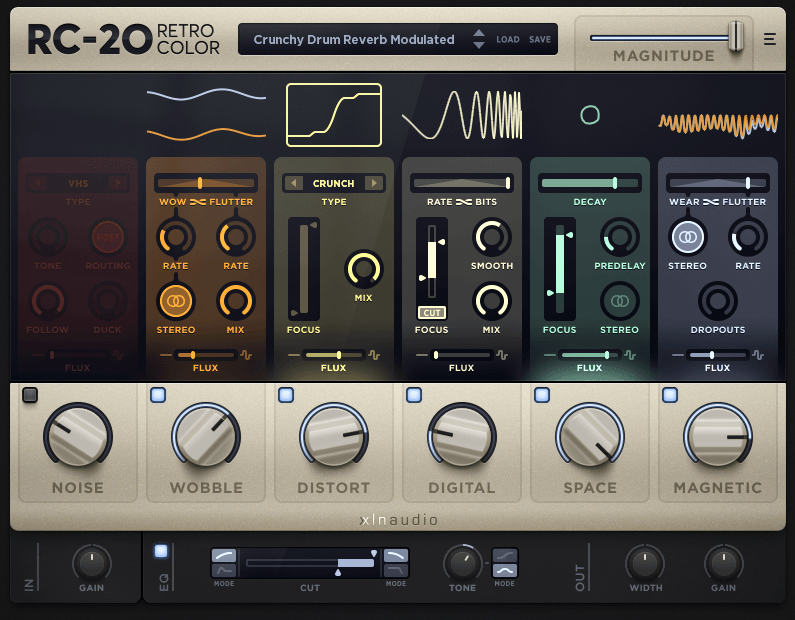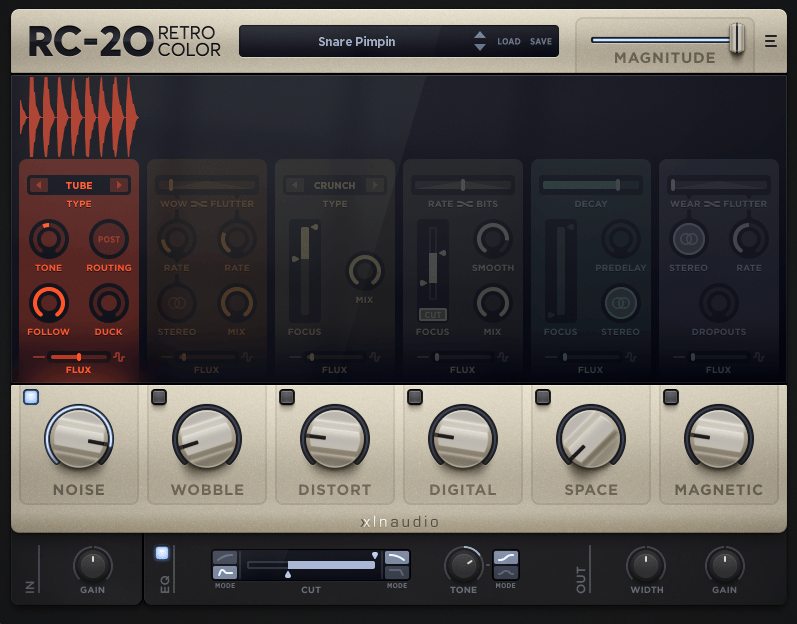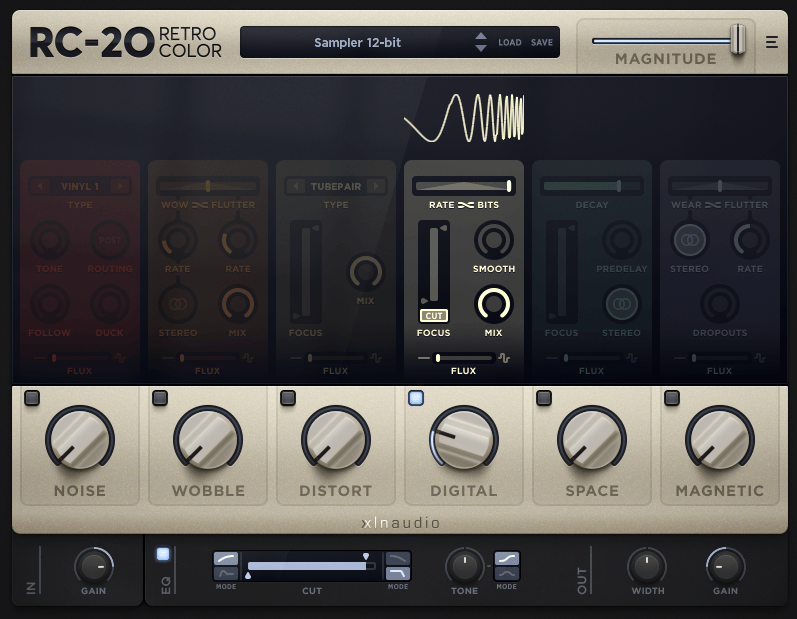The RC-20 Retro Color plugin by Swedish company XLN Audio is certainly one of the most popular and versatile LoFi plugins. It has just the right balance of flexibility and ease of use and it sounds just awesome for LoFi synths, keys and guitars.
However, if you dig a little deeper the RC-20 Retro Color can be used in ways that are not limited to the typical LoFi sounds. In this article you are going to explore three rather uncommon ways to bring life and punch to your drums with the help of the RC-20.
| This post contains affiliate links. If you make a purchase through these links, we may earn a commission at no extra cost to you. It’s a simple way you can support our mission to bring you quality content. |
1. Add a Human Feel to Programmed Drums
The problem with programmed drums is that they can sound very static and robotic. In some cases this is exactly what a beat calls for. But most of the time I found that adding at least a subtle amount of movement will make the beat a lot more interesting to listen to.
There are many ways to do that. One of them is adding slight timing inconsistencies. Another way is to vary the tone, pitch and volume of the individual drums. And this is where the RC-20 Retro Color comes into play and here is how it works:
Insert an instance of RC-20 on each drum channel. The RC-20 is also cool on the drum bus, but we are talking about individual drums here.
Side Note: You may want to leave certain drums untouched from this treatment. However, I suggest you try it on every drum channel now, so you have a better foundation for later judgments.
Modulate Timing and Pitch to Emulate Human Imperfection
Turn down all the big knobs – the ones below each module – except for the Wobble module. Wobble modulates the pitch. The Wow/Flutter slider on top of the module determines the mix of fast (Flutter) and slow (Wow) pitch modulation. Adjust to taste as well as the two Rate controls, which determine the modulation speed of Wow and Flutter.
The Flux slider randomizes the modulation speed and depth, which will make it sound more organic.
Now adjust the overall depth of the effect with the Big Knob. In most cases a subtle amount works better. We are after a more organic feel here and not so much after an obvious effect.
The Stereo button can add a cool effect, as it spreads Wow and Flutter to the left and right channel. Try it out.
More Movement Through Level and Tone Modulation
Now turn on the Magnetic module by turning up its Big Knob to add some level and tone modulation. The Wear/Flutter slider on top of the module determines the balance of level inconsistencies (Wear) and another instance of pitch modulation (Flutter). Dropouts adds random volume dips that are more extreme than the ones added by Wear.
Adjust the Flux slider to randomize the fluctuations and adjust the strength of the effect with the Big Knob.
The Stereo button spreads the Wear and Dropout effects to the left and right channel, which can be cool. Just try it out and hear if it fits.

2. Add a Dope Space and Glue to Your Drums
One of RC-20 Retro Color’s six modules is a reverb module called Space. While the main use of the RC-20 is degrading individual tracks and buses, the Space module calls for use as a juicy send fx reverb. This works with all kinds of instruments, but let’s stay with the drums in this article.
The main advantage of sending individual drums to the same reverb is that it glues them together in a natural way. It is kind of like placing them in the same room – even if the reverb itself doesn’t sound like a natural room. And the RC-20 doesn’t sound like a natural room!
So why not simply put a reverb on the drum bus? Because you wouldn’t be able to control the amount of reverb for each individual drum. With a send effect you can.
A Reverb With an Attitude
The Space module has a distinct grainy LoFi sound. And it’s quick to dial in and shape its tone via the focus sliders.
Here is how you do it:
Set up a return channel with the RC-20. Turn all modules off except Space. Now send your drums to the RC-20. Usually I like to leave my kick drums dry.
Now tweak the Space module to taste. As I mentioned, the Space module is on the LoFi side of reverbs. Set it to Mono for more LoFi! Leave it in stereo for a broader sound.
Use the Focus sliders to further shape the reverb’s sound. Their effect is similar to high- and low pass filters.
Don’t forget to use the Flux slider to dial in some extra weirdness.
Put Your Drums in Out Of This World Spaces
When you’ve set up Space you can experiment with RC-20s other modules to create a subtly or wildly modulated reverb. This is what really sets this plugin apart from other reverbs.
You can also experiment with putting the RC-20 Retro Color before or after other reverb plugins. Or any kind of send plugin for that matter. Once you start using the RC-20 in send effects chains the options become…well maybe not endless…but kind of.

3. Add Dirt and Fatness to Snares and Claps
The XLN Audio RC-20 Retro Color plugin is great for adding texture to drums. It is capable of making thin drums sound fatter and add grit to already dope drums with just a few tweaks. I find it to be working especially well with snares and claps.
The main trick is to add noise to the drums, but only to the hits and not in between them. With RC-20 this is super easy.
Add Some Noise to Make Your Drums Fatter
Put an instance of the RC-20 plugin as an insert in your snare channel. Turn off all the plugins modules except the noise module.
In the noise module, choose a noise type. The vinyl and tape noises, as well as white and pink noise work great, but you should definitely try the other noise types as well. You never know what gives your snare that extra.
Set the routing to PRE so the noise is added directly to the snare. Post would add the noise after all the other modules.
Turn Duck all the way down and Follow all the way up. This will make the noise be added only to the snare. With the big knob you can control how much of the noise is been added.
Now shape the tone of the noise with the tone control. Finally, play with the flux slider for more randomness of the effect.

4. Bonus: Adding Vintage Sampler Vibe to Your Drums
What about adding some vintage sampler grit to your drums? For that matter we’re going to use the Digital module. What this does is, that it reduces the sample rate and the bit depth. A big part of the sound of vintage samplers comes from their low bit depth and sample rate and with the digital module we can emulate that.
Switch the digital module on…wait a second…let’s take the easy route – which we should be doing whenever it makes sense. Go to the preset menu and load “Sampler 12-Bit”. (Some of the most iconic samplers like the MPC 60 and the SP-1200 where operating with 12 bits.)
Crunchy Drums Through Bit Reduction
Now what you will hear is that your drums will have more crunch and grit, which helps your drums cut through in a mix. To increase that effect, turn the big knob of the digital module further to the right. But be careful, as you’ll notice the sound starts to get really harsh and then destroyed the further you turn the big knob.
To understand what’s happening we have to look at the digital modules settings. In the “Sampler 12-Bit” preset, the Digital module is the only active module in RC-20. The Rate/Bits slider on top of the module, which blends the amount of sample rate and bit reduction, is all the way on the Bits side. That means that only bit reduction and no sample rate reduction is taking place.

A Closer Look to RC-20 Retro Color’s “Sampler 12-Bit” Preset
In its initial state after loading the preset the big knob is at about 10 o clock, which more or less represents a reduction to 12 bits. As the RC-20 doesn’t show any values we can only guess – and listen. Everything else in the module stays untouched.
However, when you take a look at the master section at the bottom of the plugin, you’ll notice that the EQ is switched on and that the top end is cut. This is what kinda emulates the reduced sample rate of vintage samplers.
Now, the sound designers could also have used the Rate/Bits slider to blend in some sample rate reduction, which results in a harsher sound. Try it out and decide what you like.
More Crunch and Dirt for Your Drums
In case, you like your drums a little dirtier or crunchier, RC-20 comes with 3 more vintage sampler presets: “Sampler 12-bit (Noisy)”, “Sampler 8-bit” and “Sampler 8-bit (Noisy)”.
The “Noisy” versions add noise, distortion and tape wear via the Noise, Distort and Magnetic modules and I highly encourage you to try them out.
Final Thoughts
While the RC-20 Retro Color plugin is best known as a dope sounding and fun to use LoFi plugin suite – some call it the mother of LoFi plugins-, it can be used beyond the LoFi context. In this article we explored three unusual ways to use the RC-20 Retro Color for dope drums.
Movement…
With the Wobble and Magnetic modules you can add movement to drums through subtle modulation of time, tone and pitch.
Space…
While in most cases the RC-20 is used as an insert effect, the Space module makes for an awesome Lo-Fi reverb and screams for use as a send effect to add depth, space and glue to your drums in a controlled but very cool manner.
Fatness…
With the Noise module we added texture and fatness to thin drums by adding a Vinyl or Tape noise to drum hits but not in between the hits.
And Crunch…
Finally, we added some vintage sampler like grit and dirt to the drums, so they get that old school vibe and cut through in the mix. With the Digital module the bit depth and sample rate can be reduced, which is a key factor to the sound of vintage samplers. Luckily the RC-20 Retro Color plugin comes with 4 dedicated “Sampler” presets which serve as a good starting point.
-> Dope Drums!
I hope you could get some inspiration to use the RC-20 Retro Color beyond its more obvious use for LoFi synths, keys and guitars. This plugin is capable of a 1000 things and more and is totally worth exploring and experimenting with.
Now go give your drums the punch, life and grit they deserve!
Have fun and stay creative:-)
How do you use the RC-20 Retro Color? Do you have any questions regarding my article? Let me know in the comments.
